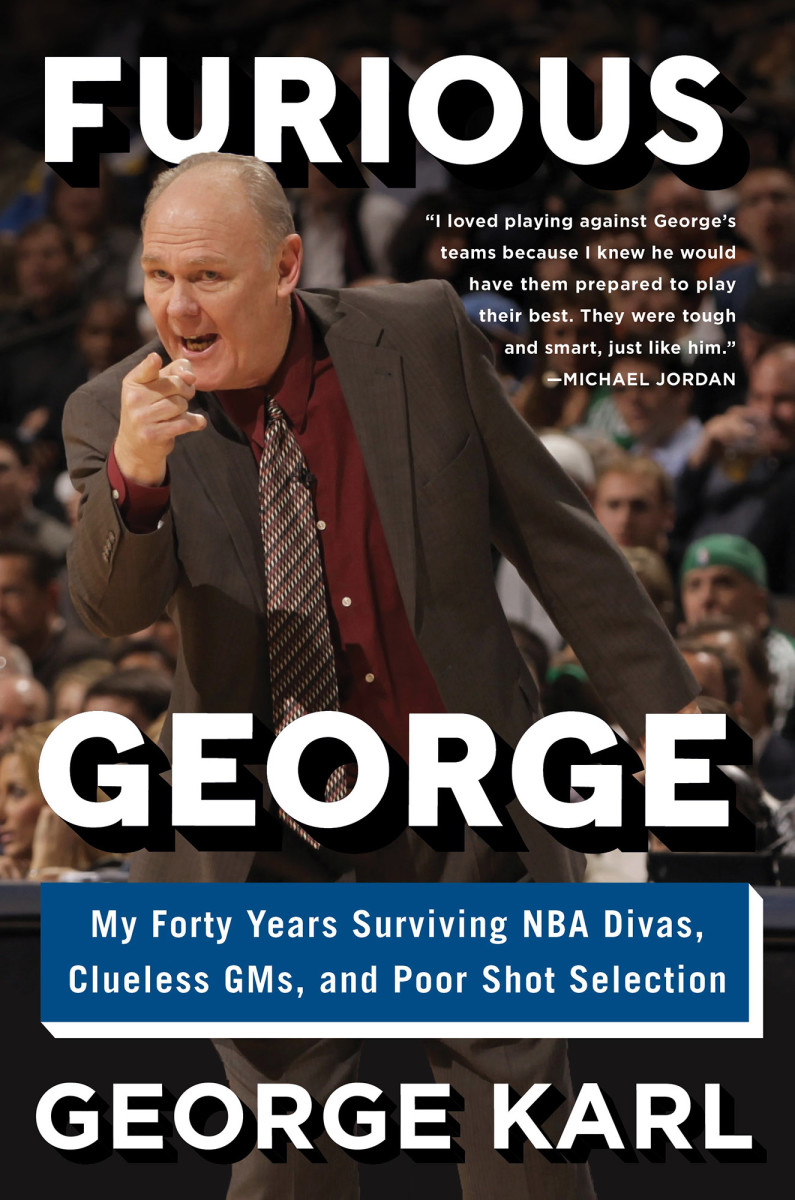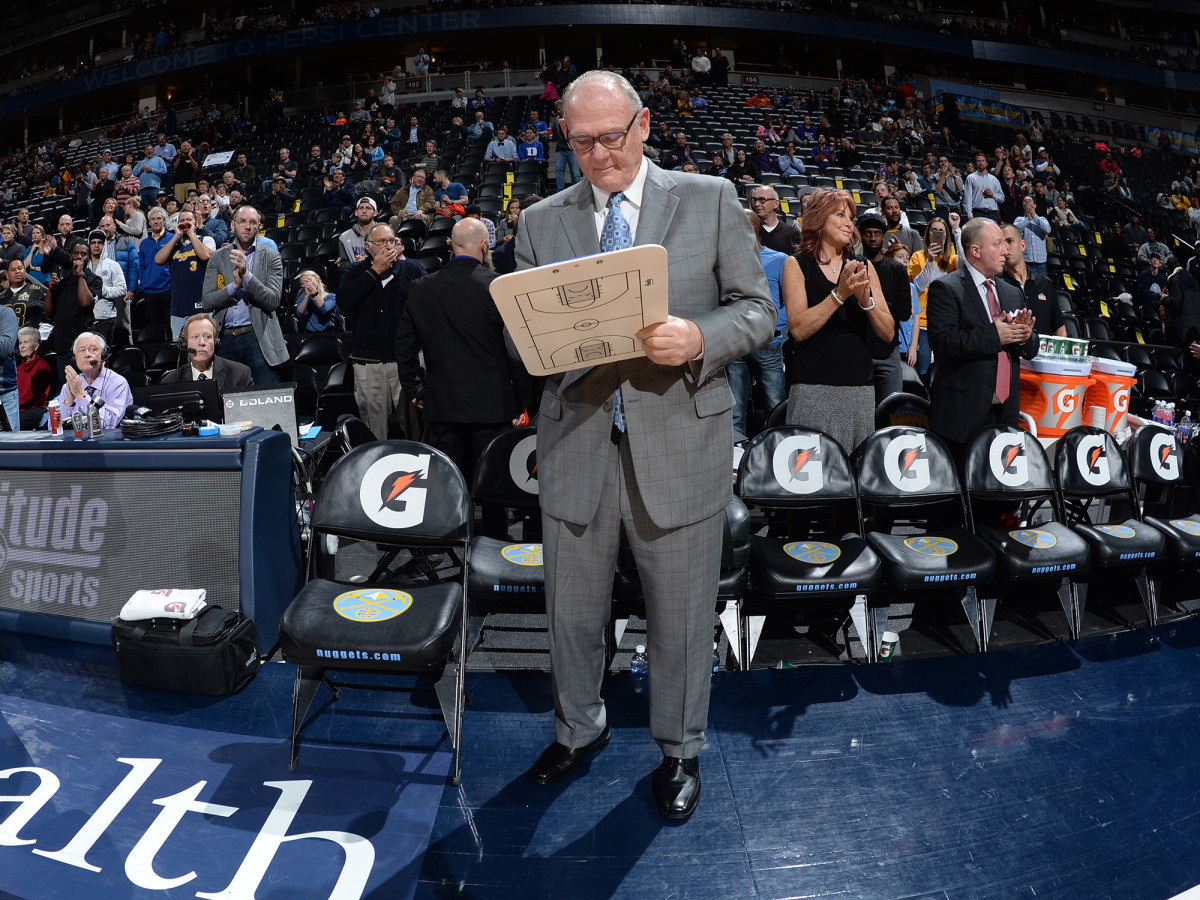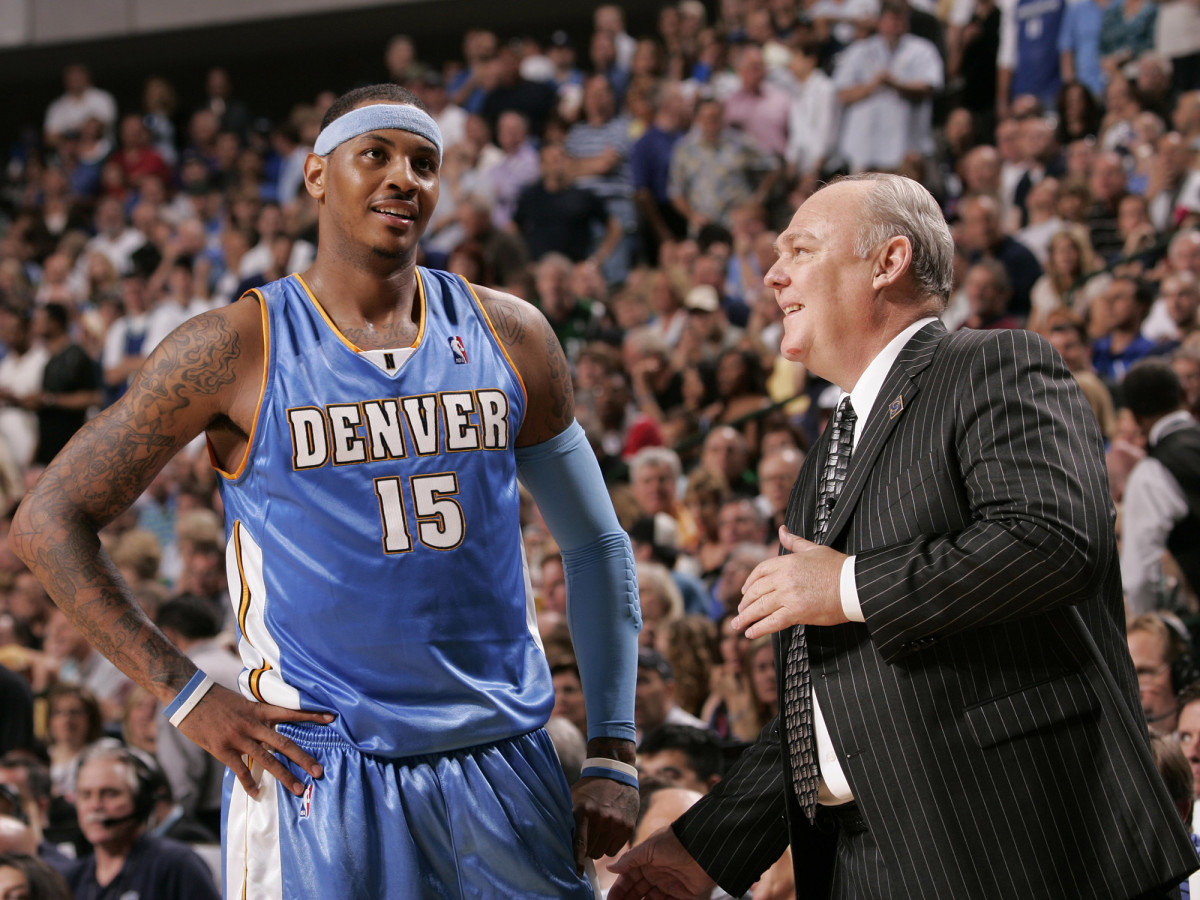George Karl On His WTF Moments In The NBA

The following is excerpted from Furious George by George Karl. Copyright © 2016 by George Karl. Re-printed with permission of Harper, an imprint of Harper Collins Publishers. All rights reserved.
The Nuggets team that I would try to lead and coach had three AAU babies: the starting forwards, Kenyon Martin and Carmelo Anthony. And J. R. Smith.
Kenyon snapped first.
In order to create a team that can play well together, I try to figure out my players and their motivations. Which guy is a leader? Who can follow effectively—followers are always dissed, but they’re as important as leaders—and who will always rebel against authority? Who is confident and who is covering up? What personalities might work best together?
I knew right away that our power forward was one of the most insecure, immature players I ever coached. Kenyon Martin had grown up poor in South Dallas. Single-parent home; his mother worked two jobs. He was teased unmercifully, for his stutter, and for his skin color. The other kids didn’t think he was black enough, so they called him Yellow Boy. That must have been miserable, but he found some refuge in sports, especially in high school and AAU basketball. The University of Cincinnati won the battle for his services. The Nets had first pick in the 2000 draft and they took Kenyon.

Furious George
by George Karl
The most outspoken and combative coach in NBA history reflects on forty years of surviving NBA divas, clueless GMs and poor shot selection.
Out of anger at the world, poor impulse control, a strange form of showing off, or whatever, Kenyon decided that he was an intimidator, and he got many, many suspensions and fines. His absolutely stupid $345,000 worth of fines in 2001–02 got him a Sports Illustrated cover during the 2002 finals. “Bad Boy,” the headline read. “Nets Flagrant Flyer Attacks the Playoffs.” The Nuggets had traded for him the year before I got there. His deal: seven years, $93 million.
Let’s jump ahead a little bit, to the 2006 playoffs. After coaching him for a year and a half, I knew that Kenyon was really good. He could rebound, run, and defend. His straight-ahead offensive style was a nice contrast with Carmelo’s flashiness. But his knees were a problem; he missed about thirty games that season. In the locker room at halftime of Game Two of our first-round series with the Clippers, he b----ed loudly about only playing seven minutes in the first half.
“I ain’t playin’ in the second half,” he said. “You’re not playing?” I said.
“Not f---ing playing. You need a hearing aid?”
The second half started—no Kenyon. He came out of the tunnel after a while, put a towel on his head, and sat on the bench like a statue until the game was over.
We lost the game and were about to lose the series. I was pissed at the insubordination. Also incredulous: who’d ever seen such a thing? But if I came back hard, with anger, I knew I’d only make the situation worse. I remembered how Gary Payton and I were at each other’s throats until, after more than a year, we found some common ground. I knew I had to work with this guy, keep trying to figure him out.

We suspended Kenyon for the next two games, saying we couldn’t tolerate such disrespect to the coach and to the team. But I was calm when I met the media after the game. I gave his ego a little break by taking some of the blame.
“I understand Kenyon’s gone through a tough year,” I said. “I know he’s frustrated at the coaching, his knee, his playing time. I’m part of this failure, part of this relationship. I think I can get better from this, and hopefully he feels the same way. I think Kenyon’s a damn good player and he has a competitive heart I love.”
Maybe I was getting better at dealing with eccentric players. But then: Carmelo.
Did I handle him as well? The volume of questions about Carmelo eventually wore me down. Sometimes I got so sick of talking about him that I’d just throw up my hands and say, “I don’t know what he is and I don’t care.”
Carmelo was a true conundrum for me in the six years I had him. He was the best offensive player I ever coached. He was also a user of people, addicted to the spotlight, and very unhappy when he had to share it.
Wait. There’s more.
He really lit my fuse with his low demand of himself on defense. He had no commitment to the hard, dirty work of stopping the other guy. My ideal—probably every coach’s ideal—is when your best player is also your leader. But since Carmelo only played hard on one side of the ball, he made it plain he couldn’t lead the Nuggets, even though he said he wanted to. Coaching him meant working around his defense and compensating for his attitude. I’d have to try to figure him out, too. How could I get more from him?
Carmelo grew up poor in West Baltimore. Single-parent home; his father died when he was two. With the drugs and violence in his neighborhood, it must have been like a combat zone. But like Kenyon, he found a safe place under a hoop on the playground. Hard work, skill, talent, and lucky DNA got Carmelo into a private high school and onto an AAU team. He put himself on the map when he averaged 25 a game at the AAU’s Adidas Big Time Tournament in Vegas. Syracuse won the competition for his services, and he played one year in college, as mentioned, and won an NCAA championship. His deal with the Nuggets as a 19-year-old rookie was for five years and $80 million.
He was such a talented kid. If he’d decided to lead the league in rebounding, or to become the best defender at his position in the NBA, he could have done either one.
But Kenyon and Carmelo carried two big burdens: all that money, and no father to show them how to act like a man. As you’ve read, I grew up in a safe suburban neighborhood, with both my parents. I had a second father in my college coach, the most moral, decent man I ever knew. And I never made enough money as a player to get confused about who I was. When I compare my background to Kenyon’s and Carmelo’s, it’s no wonder we had a few problems.
J.R. had a slightly different story. He went straight from high school in New Jersey to AAU success to the NBA. His father was on the scene and in his life, which is obviously good. But Earl Smith Jr. urged his son to shoot the ball and keep shooting it from the very moment I put him in a game, which is obviously bad.
In his defense, sometimes J.R. can make it from anywhere and score in bunches. But I wanted defense and commitment to the team. What I got was a player with a huge sense of entitlement, a distracting posse, his eye always on his next contract, and some really unbelievable shot selection.

For example, near the end of a close Game Five in the first round of the 2007 playoffs, I drew up a play that had Melo or Allen Iverson shooting. (We’d traded for AI. More on that later.) But J.R. got the ball first and took a guarded three that missed. “I have no idea what planet that came from,” was my reaction after the game. With eight seconds left, and the game still theoretically winnable, J.R. put it up from half-court, the shot that inspired my sarcastic remark at the beginning of this chapter. It was quite easy for J.R. to play basketball in a way that mocked the very essence of the sport as well as any concept of being on a team, let alone trying to do the smart things that lead to victory. I could not understand him at all. I kept his ass on the bench a lot, the coach’s last resort. The media called him my whipping boy, displaying the fundamental lack of awareness so common in beat reporters. I had no need for a whipping boy. I needed players on the court I could count on.
He had problems off the court, too, which is none of my business. Until off the court affects on the court. J.R. collected cars. He drove them fast, resulting in tickets and license suspensions. He also got some jail time for a 2007 crash that killed his passenger, his friend Andre Bell. He kept getting speeding tickets between the accident and the sentencing, so the NBA suspended him for seven games.
When we traded J.R. in 2011, I was disappointed that I hadn’t helped a clearly talented player advance his game more.
Thinking about Kenyon, Melo, and J.R. now reminds me of the player my friends always asked about: the guy with the Woody Woodpecker haircut and the vast acreage of Technicolor tattoos.
People assume that Chris “Birdman” Andersen was crazy but he may have been the sanest guy on those Denver teams. He was no AAU baby. No one in college or pro basketball really wanted him. Despite a broken home and poverty in his childhood, and a two-year suspension from the NBA for drug use, Chris built himself into a really good defensive center and the Nuggets’ most popular player.
He may have looked a little unusual—okay, a lot unusual—but more than once he truly calmed me down during game. “You’re coaching too much, Coach,” the Birdman would say.
Or was that Chris talking?
Some great athletes, Ben Hogan and Ted Williams, for example, had alter egos, imaginary versions of themselves that somehow helped them perform better. Chris was a mild-mannered man who became a flamboyant and pretty good player when he flapped his wings as the Birdman.
We had another player on the Nuggets with an alter ego. JaVale McGee’s second identity is “Pierre.” Pierre has facial hair on his upper lip so JaVale got a tattoo of a handlebar mustache on the inside of his right index finger. He holds this finger under his nose when he summons Pierre. Maybe he is trying to tell the basketball gods that it’s Pierre’s fault when JaVale does something stupid on the court. He’s a talented player when every switch is on and the plug is in. But he’s got a lot of plugs and switches. As noted, I didn’t really understand JaVale.

Meanwhile, Carmelo Anthony . . .
Our main problem was that he liked to separate himself from our team. A player can talk back to me, we can argue, but that’s between us. One player is a lot less important than how everyone performs together. I don’t think Melo cared enough about being a good teammate.
But he got away with some shit over the years because he made All-Star teams and averaged 24-6-3 (points, rebounds, assists). His incidents were spaced out, so listing them here may make them sound worse than they were. If all my screwups were compressed into one paragraph, I’d look pretty bad, too, but Melo had a pattern of bad judgment.
He got a DUI; he got busted at the airport for having a bag of weed in his backpack; he got in a bar fight; he got suspended for fifteen games for punching a Knick during our infamous brawl in 2006. And he did a Kenyon when he refused to go back into the last minute or two in a game on the road against the Pistons. That didn’t make his coach too happy.
But his real WTF moment occurred in March 2009 in the third quarter of a game against the Pacers. Carmelo had not scored much all night but then made two in a row. It was time for him to come out for a rest so I sent in his backup, Linas Kleiza, as I usually did. At the next dead ball, LK went in. But Carmelo refused to come out! After long moments of people staring at each other in confusion, but before we got a technical foul for having too many men on the court, Kenyon, to his credit, walked to the bench.
Well, well, well. Here was a new wrinkle in the coach/player power struggle, one I’d never seen before. It was also an incredible F-U to me. We suspended him for the next game.
After the game, which we lost 100–94, I had to talk to the media about it. Should I show my disgust at Melo’s childishness and lack of respect? No. I tried to be calm and understanding of behavior I couldn’t understand at all. So I swallowed my tongue. “There’s a thin line between passion and emotional immaturity,” I said. “It happens all the time, to coaches, too. We snap and act like idiots on the sideline because of the emotional stress of the game.”
The positive side of this incident was that it embarrassed Carmelo. He played harder and better for a while. Not coincidentally, we made a deep playoff run.
